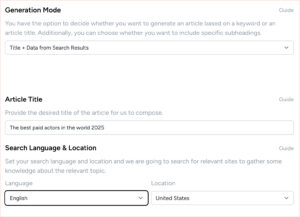You’ve always felt a deep connection to the environment, and you want to do more than just recycle and turn off lights when you leave a room. What if you could amplify your impact, inspiring others to join you in the fight for a sustainable future?
Welcome to the world of blogging for environmental sustainability, where your passion for the planet meets the power of words. Imagine reaching thousands, even millions, with:
- Compelling stories
- Practical tips
- Urgent calls to action
Whether you’re a seasoned blogger or just starting out, this guide will equip you with the tools and knowledge to make your eco-friendly voice heard.
You’ll discover how to:
- Craft engaging content
- Leverage social media
- Connect with like-minded communities
Ready to turn your keyboard into a tool for change? Let’s dive in and explore how you can make a lasting difference through your blog.
Importance of Environmental Sustainability
You can’t overstate the importance of environmental sustainability in preserving our planet for future generations.
It’s not just a buzzword; it’s a call to action that invites you to be part of a community dedicated to making a difference. By focusing on eco-friendly practices, you’re contributing to a healthier world.
One powerful way to do this is through green web hosting.
This involves using hosting services that:
- Operate on renewable energy
- Implement energy-efficient technologies
When you choose green web hosting for your blog, you’re reducing your carbon footprint and supporting a sustainable future.
Imagine the impact if everyone took small steps towards environmental sustainability.
You’d be part of a collective effort that amplifies positive change. Your blog, powered by eco-friendly resources, sends a message that resonates with readers who care about the planet too.
It’s more than just writing; it’s about building a community that values and practices sustainability.
Choosing Eco-Friendly Blog Topics
Selecting topics that promote sustainable practices can make your blog a valuable resource for readers committed to protecting the planet.
Focus on eco-friendly subjects that inspire your audience to take actionable steps toward environmental sustainability.
Share tips on reducing waste, such as:
- DIY composting
- Creating zero-waste kitchens
Highlight the benefits of green web hosting and how it contributes to a smaller carbon footprint.
Discuss current trends in sustainable fashion, featuring brands that prioritize:
- Ethical production
- Eco-friendly materials
Dive into the importance of renewable energy sources and how individuals can transition to:
- Solar power at home
- Wind power at home
Offer practical advice on sustainable travel, such as:
- Choosing eco-friendly accommodations
- Eco-friendly transportation
By covering these topics, you create a sense of community among readers who share your commitment to environmental sustainability.
Your blog becomes a hub for like-minded individuals eager to learn, share, and grow in their journey towards a greener lifestyle.
Tips for Green Web Hosting
To minimize your blog’s carbon footprint, consider these practical tips for choosing a green web hosting provider.
First, look for hosts that prioritize environmental sustainability by using renewable energy sources like wind or solar power. Many green web hosting providers proudly display their eco-friendly certifications, so check for badges from organizations like Green-E or Energy Star.
Next, investigate their data centers:
- Efficient data centers use advanced cooling techniques.
- They employ energy-efficient hardware to reduce power consumption.
- Some providers participate in carbon offset programs, investing in projects that reduce CO2 emissions to balance out their environmental impact.
Don’t forget to examine their company policies:
- Providers committed to eco-friendly practices often have transparent sustainability reports.
- They actively support green initiatives.
- Feel free to reach out and ask questions—community-driven companies are usually more than happy to share their efforts.
By choosing a green web hosting provider, you’ll join a network of like-minded individuals dedicated to making the internet a more sustainable space.
Sustainable Blog Design Practices
Creating a sustainable blog involves making mindful design choices that reduce energy consumption and enhance user experience. By adopting eco-friendly design practices, you’re not only contributing to environmental sustainability but also creating a sense of belonging within a community that values the planet.
Start by simplifying your site’s design. A clean, minimalist layout reduces server load and speeds up your site, cutting down on energy use. Opt for lighter themes and fewer high-resolution images to minimize data transfer.
Choose green web hosting providers that use renewable energy sources. This ensures your blog operates with a lower carbon footprint.
Compress your images and use efficient coding practices to further reduce energy consumption.
Optimize your blog for mobile devices. Mobile-friendly designs consume less data and energy, making your blog more sustainable while reaching a wider audience.
By implementing these sustainable blog design practices, you’re playing an essential role in promoting environmental sustainability and fostering a community that cares about making a positive impact.
Writing Engaging Eco-Friendly Content
Crafting compelling content that highlights sustainable living can inspire your readers to adopt eco-friendly habits in their daily lives.
Start by sharing relatable stories that showcase real-life applications of environmental sustainability. This helps your audience feel connected and motivated to make small changes.
When you discuss eco-friendly practices, use clear, actionable tips. For example, guide your readers on how to:
- Reduce plastic use
- Create a zero-waste home
Your content should feel like a conversation, offering practical steps they can implement right away.
Don’t forget to highlight your commitment to green web hosting. Explain how using eco-friendly hosting services reduces carbon footprints, making your blog a part of the solution. This not only educates your audience but also builds trust and a sense of community.
By creating engaging and informative content, you’re fostering a space where readers feel they belong and are empowered to contribute to a more sustainable future.
SEO Strategies for Environmental Blogs
Optimizing your environmental blog for search engines can significantly boost your visibility and reach a broader audience interested in sustainability.
Start by incorporating keywords like "environmental sustainability," "eco-friendly," and "green web hosting" naturally within your content. This helps search engines recognize your blog’s focus.
Next, create high-quality, engaging content. Write articles that solve problems or answer questions related to sustainability, ensuring your readers feel part of a community striving for a better planet. Use internal and external links to credible sources to boost your blog’s authority.
Don’t forget about on-page SEO. Optimize your titles, meta descriptions, and headers with relevant keywords. Also, ensure your blog is mobile-friendly and fast-loading to improve user experience and ranking.
Lastly, consider using green web hosting providers. They use renewable energy sources, aligning your blog’s backend with your eco-friendly values and appealing to a like-minded audience.
By following these strategies, you’ll enhance your blog’s reach and impact.
Utilizing Renewable Energy Sources
Harnessing renewable energy sources is a crucial step toward reducing your carbon footprint and promoting a sustainable future. By integrating eco-friendly practices into your blogging platform, you’re not only contributing to environmental sustainability but also inspiring your readers to do the same.
Start by choosing green web hosting services.
These providers use renewable energy to power their servers, significantly cutting down on greenhouse gas emissions. By opting for green web hosting, you’re aligning your blog with eco-friendly principles, showing your audience that you practice what you preach.
Additionally, consider using solar panels or wind energy for your home office.
This not only powers your blogging activities sustainably but also sets a great example for your community. Sharing your journey with renewable energy sources can create a sense of belonging among your readers, encouraging them to adopt similar practices.
Remember, every small step counts.
Your commitment to renewable energy can inspire others to join you in the quest for environmental sustainability.
Promoting Environmental Causes
Supporting environmental causes through your blog can amplify your impact and engage your audience in meaningful action.
Start by sharing stories about environmental sustainability, highlighting the importance of eco-friendly practices. Discuss how small steps, like reducing plastic use or conserving water, can collectively lead to significant change.
Encourage your readers to participate in local clean-up events, tree planting activities, or recycling programs. Provide resources and tips on how they can live more sustainably and make eco-friendly choices in their daily lives. By fostering a community of like-minded individuals, you create a sense of belonging and shared purpose.
Consider using green web hosting for your blog to further demonstrate your commitment to the environment.
Explain to your audience how green web hosting reduces carbon footprints by using renewable energy sources. This not only aligns with your message but also inspires your readers to seek out sustainable options in their own endeavors.
Your blog can be a powerful tool for promoting environmental sustainability.
Collaborating with Eco-Friendly Brands
Partnering with eco-friendly brands can exponentially increase your blog’s reach and impact.
By aligning with companies that prioritize environmental sustainability, you not only enhance your credibility but also foster a sense of community among your readers who share similar values. These collaborations can be mutually beneficial; brands gain exposure to your dedicated audience, while you receive support and potentially financial backing.
Start by identifying eco-friendly brands that resonate with your blog’s mission.
Look for companies committed to:
- Green web hosting
- Sustainable products
- Ethical practices
Reach out with a personalized pitch emphasizing shared goals and the potential for a powerful partnership.
When you promote these brands, ensure your content remains authentic and transparent.
Showcase how their products and services contribute to environmental sustainability. This authenticity will resonate with your audience, encouraging them to support these brands and, by extension, your blog.
Together, you can drive meaningful change and build a loyal, eco-conscious community.
Measuring Blog’s Environmental Impact
Understanding your blog’s environmental impact is crucial for making informed decisions that support sustainability.
Start by evaluating your blog’s energy consumption and carbon footprint.
Hosting your blog on a green web hosting service is an effective way to reduce its environmental impact. These services use renewable energy sources, making them more eco-friendly and aligning with your commitment to environmental sustainability.
Next, consider the digital efficiency of your site.
- Optimize images
- Reduce unnecessary plugins to lower energy usage
Tools like Website Carbon Calculator can help you estimate your blog’s carbon emissions, providing a clear picture of areas needing improvement.
Don’t forget to regularly review and update your strategies.
- Engage with your community
- Share your sustainability goals
- Encourage them to adopt eco-friendly practices
By taking these steps, you’ll not only minimize your blog’s environmental footprint but also inspire a sense of belonging among readers who are passionate about sustainability.
Engaging with Eco-Conscious Audience
Connecting with an eco-conscious audience requires authentic engagement and a genuine commitment to sustainability.
You need to show that you’re not just talking the talk, but walking the walk. Share your personal journey toward environmental sustainability, and invite your readers to join you. Use eco-friendly practices in your blog operations, such as green web hosting, to demonstrate your commitment.
Engage your audience by creating content that resonates with their values.
- Write about actionable steps they can take to live more sustainably.
- Highlight real-world examples of positive environmental impact.
- Encourage discussions in the comments, fostering a community where everyone feels they belong and can contribute to the cause.
Regularly update your readers on your own sustainability efforts and be transparent about your successes and challenges.
This honesty will build trust and loyalty among your audience. Remember, your genuine dedication to environmental sustainability will inspire and empower your readers to make a difference.
How can I monetize my environmental blog without compromising its sustainability goals?
To monetize your environmental blog without compromising sustainability goals, focus on ethical partnerships.
Seek out brands that align with your values and mission.
Collaborate with eco-friendly companies for:
- Sponsored content
- Affiliate marketing
Engage your community in discussions about conscious consumerism.
Offer eco-friendly products or services that support your blog’s message.
By staying true to your values and promoting sustainability, you can monetize your blog authentically.
What are some effective strategies for managing the mental health challenges associated with blogging about environmental issues?
When managing the mental health challenges of blogging about environmental issues, it’s essential to prioritize self-care.
Key strategies include:
-
Taking breaks:
- Step away from your work periodically.
- Engage in activities that relax and rejuvenate you.
-
Connecting with a supportive community:
- Join groups or forums of like-minded individuals.
- Share experiences and offer mutual support.
-
Seeking professional help if needed:
- Consult a therapist or counselor if you’re feeling overwhelmed.
- Utilize mental health resources available to you.
Additional practices to maintain a healthy mindset:
-
Setting boundaries:
- Limit the time spent on stressful tasks.
- Balance your blogging with other life activities.
-
Practicing mindfulness:
- Engage in meditation or mindfulness exercises regularly.
- Stay present and aware of your mental state.
-
Focusing on the positive impact of your work:
- Remind yourself of the difference you’re making.
- Celebrate small victories and milestones.
Remember, your well-being is just as crucial as the message you’re sharing through your blog. Take care of yourself to continue making a meaningful impact.
How do I handle negative comments or backlash from climate change skeptics on my blog?
When dealing with negative comments or backlash from climate change skeptics on your blog, it’s important to stay calm and composed.
Remember that not everyone will agree with your views, and that’s okay.
Respond respectfully and factually, focusing on educating rather than arguing.
- Engage with constructive criticism
- Don’t let hateful comments affect your mental well-being
Surround yourself with a supportive community that shares your values and beliefs.
Conclusion
In conclusion, blogging for environmental sustainability is a powerful way to make a positive impact.
By choosing eco-friendly topics, using green web hosting, and writing engaging content, you can inspire others to take action for the planet.
Steps to enhance your eco-friendly blog:
- Choose eco-friendly topics.
- Use green web hosting.
- Write engaging content.
Collaborating with eco-friendly brands and promoting environmental causes further amplify your reach.
Remember, every post counts towards creating a more sustainable world.
Keep up the great work and continue engaging with your eco-conscious audience!





